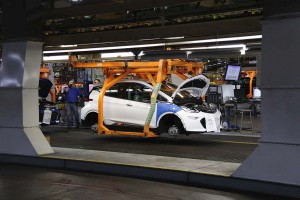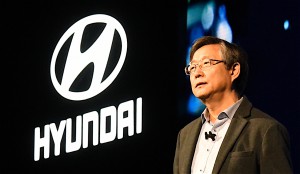
General Motors CEO Mary Barra recently signed off on a plan to expand the company's portfolio of electric vehicles.
While there are only a handful of long-range electric vehicles on the market right now, you can expect to see as many as two dozen or more in U.S. showrooms by the end of the decade, and several times as many five years from now.
Virtually every major automaker has promised to “electrify” its line-up, and companies like General Motors, Toyota and Daimler AG plan to put a premium on pure battery-electric models. While that may be great news for green-minded auto buyers, there’s a serious flaw in the equation for auto manufacturers, says Woong-chul Yang, the head of R&D for both Hyundai and its sibling brand Kia.
“Whenever we sell eco-friendly vehicles we all lose money,” the South Korean executive told TheDetroitBureau.com after presiding over the rollout of the new Kia Niro EV at the Consumer Electronics Show last week. “Even battery vendors are losing money.”
That’s a frustrating fact of life for Mary Barra, as well. Nonetheless, the General Motors CEO recently signed off on a plan to expand the company’s current long-range line-up from one model, the Chevrolet Bolt EV, to three by early 2019, and to “at least” 20 by 2023.
(Barra commits to 1M EVs on global roads by 2026. Click Here for the story.)
Although these energy-efficient models may be needed to meet increasingly strict global emissions and mileage standards, Barra is not willing to accept them as corporate charity cases. The auto industry’s first woman CEO is determined to change the equation and not only make EVs more affordable, but also more profitable.

GM is looking to expand the number of oure EVs it offers from just the Chevy Bolt to more than 20 vehicles in short order.
“We’re talking about launching a large number of EVs … by the middle of the decade,” Barra told TheDetroitBureau.com during a conversation Saturday evening, “and (GM will reach) profitability before then.”
A key to getting there will be driving down battery costs, Barra and several other GM executives said, during conversations following the debut of the 2019 Chevrolet Silverado pickup.
The first step will come with the introduction of a new platform specifically designed for GM’s upcoming battery vehicle line-up. It will be optimized to take advantage of that technology. And it will be designed for production in much larger volumes than the Bolt which accounted for sales of just 23,000 vehicles in 2017, said GM President Dan Ammann.
“It’s about getting to greater scale,” he explained, “and taking costs down.” Especially battery costs.
The industry has already seen the price of lithium-ion technology tumble. At the beginning of the decade, when the Chevy Volt plug-in hybrid was being developed, a kilowatt-hour of lithium-ion batteries cost anywhere from $700 to $1,000. GM is spending about $140 per kWh for the batteries on the Bolt EV, Ammann acknowledged. To put that into perspective, the cost of that electric vehicle’s 64 kWh of batteries would have come in at anywhere from $42,000 to $60,000 in 2010. That’s now around $8,400.
(Click Here for details about GM wanting approval for driverless robo-cabs in 2019.)

Hyundai's Woong-chul Yang says that despite the progress on pricing, automakers are still losing money on each EV sold.
Ammann said GM expects to get that down to $100 a kilowatt-hour in the next few years. But a new study released last week by the Boston Consulting Group sees a figure closer to $70 by around 2022, which Thomas Dauner, head of BCG’s auto practice said could put the price of an EV on a comparable footing with gas-powered vehicles before mid-decade. In turn, the consultancy is betting that nearly two-thirds of the vehicles sold in the U.S. by 2035 will use some form of electrification, whether hybrid, plug-in or pure battery-electric.
How to further drive down battery prices is one of the biggest challenges the industry faces – in part because of the price of raw materials used in the technology, particularly cobalt, which has been trading in the range of more than $75,000 a ton. While other ingredients, including lithium, have soared during the last several years, cobalt is the single most expensive ingredient in modern rechargeable batteries and GM would like to shift to less of that metal and more of alternatives like nickel for its new EMC 1.0 batteries.
GM is by no means the only manufacturer working to cut prices on batteries and the rest of an electric vehicle’s hardware. But it has ranked second only to Toyota in terms of the number of patents issues in recent years.
“GM was issued 661 U.S. patents on battery technology from 2010 through 2015, the latest that such data is available from the United States Patent and Trademark Office,” reported the Reuters news service last week, “trailing only Toyota’s 762 battery patents among global automakers.”
Toyota, however, also may be in a position to leapfrog its U.S. rival. The Japanese giant last week announced it will build a new, $1.6 billion assembly plant in Alabama as part of a partnership with Mazda. That factory will produce a number of vehicles, including a new line of battery-electric vehicles. Notably, Toyota has broadly hinted it wants to power them with an entirely new generation of batteries known as solid-state.
BCG analysts estimate that technology will not only pack a lot more energy into a given mass of batteries but that solid-state cells could ultimately cut another 20% off the price of a kilowatt-hour.
GM officials said they were skeptical, however. Global product development director Mark Reuss told TheDetroitBureau.com that while it’s easy to produce a small quantity of solid-state batteries in a lab, “high-volume manufacturing is still not there yet,” adding the technology is likely still at least five years from mass production – at best.
(To see more about GM’s efforts to take the full-size truck sales crown from Ford, Click Here.)
But if or when that happens, it could help GM, as well as rivals like Toyota, solidly transform money-losing EV lines into the competitive and profitable products the industry will need them to be – especially if electric vehicles are to become more than just a small niche in the market.

First step, Mary, would be to stop giving $10,000 rebates on the Bolt.